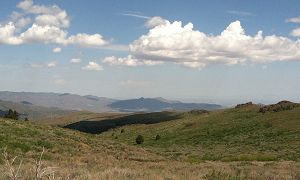Reynolds Creek Virtual Tour
Grades 6 -
14
Biogeochemistry • Biology/Ecology • Climatology/Meteorology • SoilScience/Pedology • Outreach/EducationResearch
Tour • Video • Website • Information
Educational Objectives
Objectives being written.
Tracking Snow: Measuring Nature’s Water Reservoir.
Organic Carbon: The Key Variable in a Changing Climate.
Inorganic Carbon: A Different Type of Carbon.
Predicting Soil Thickness: Anywhere on a Landscape.
CORE Sites: The Most Advanced Ecosystem Measurements Anywhere.
Audience
K-12
General Public
Higher Education
Observatory: Reynolds CZO
Author(s): Sindelar, H., Kanode, C., and S. Lanier. Montana State University. School of Film & Photography.
Funding: The Reynolds Creek Critical Zone Observatory: EAR # 1331872 and ICER # 1445246
Details for this Resource
Tracking Snow: Measuring Nature’s Water Reservoir. The Reynolds Creek Experimental Watershed has been at the forefront of snow measurement since the infancy of snow science. Danny Marks, a snow hydrologist, has helped develop instrumentation that is used to measure the snowpack all across the Western U.S. In the video, he explains the history of snow measurement at Reynolds Creek and why it is important to know how much snow has fallen in any given winter.
Organic Carbon: The Key Variable in a Changing Climate. The National Science Foundation Reynolds Creek Critical Zone Observatory was established to better understand organic carbon in sagebrush steppe ecosystems. As our climate changes, sagebrush steppe ecosystems are going to change as well. In the video, Dr. Marie-Anne de Graaff shares her research, which focuses on predicting these changes and how they could affect this ecosystem’s ability to help sequester carbon from the atmosphere.
Inorganic Carbon: A Different Type of Carbon. Most soil research focuses on measuring organic carbon. The type of carbon that comes from the breakdown of plants and other living things. Dr. Jen Pierce focuses on a different type of carbon, inorganic carbon. Often overlooked, inorganic carbon can constitute a large part of the carbon storage in soils. Understanding it is important to get an accurate picture of carbon cycling in sagebrush steppe ecosystems. In the video, Dr. Pierce defines inorganic carbon, where it is found in Reynolds Creek, and why it is important..
Predicting Soil Thickness: Anywhere on a Landscape. What if you could predict how thick the soil was anywhere in a vast ecosystem? Nick Patton has been developing a model to do just that. Knowing a soil’s thickness is important for understanding how much carbon, nitrogen, and other nutrients are stored in soil. In the video, Nick explains how he conducts his research and how it is a game changer for soil science.
CORE Sites: The Most Advanced Ecosystem Measurements Anywhere. Reynolds Creek is home to five CORE sites. These CORE sites are heavily instrumented areas carefully distributed across the climatic and elevation gradients of the Reynolds Creek watershed. They provide detailed datasets which scientists use to create models of sagebrush steppe ecosystems. These models are then used to help make predictions about similar ecosystems in other areas of the U.S and the world. In the video, Dr. Aaron Fellows explains the types of measurements made at CORE sites and why making such detailed measurements of sagebrush steppe ecosystems is helpful to all scientists.
Explore Further

